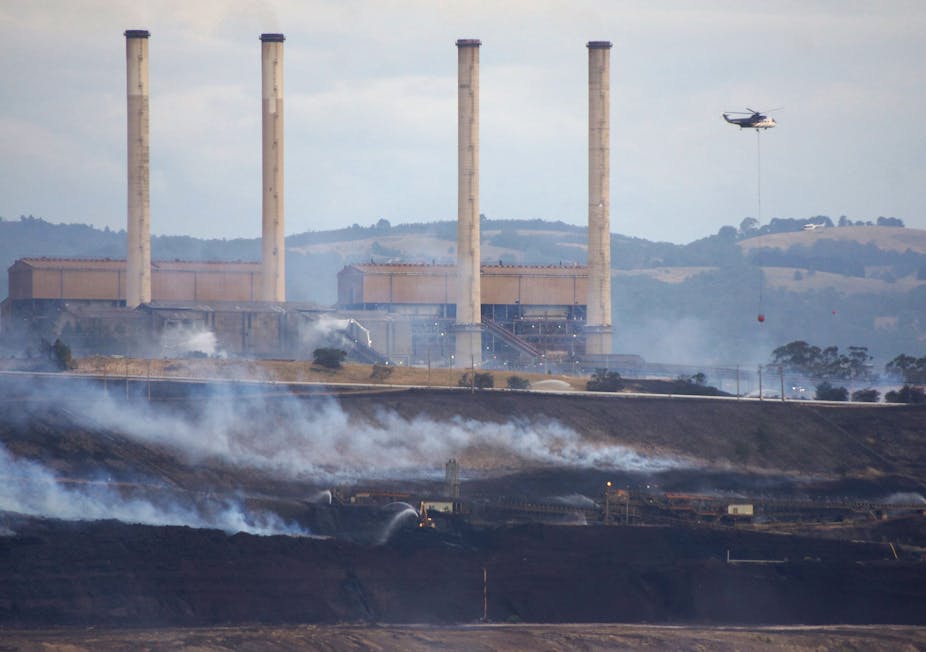Pregnant women, families with young children, people over 65, and those with heart or lung conditions have been urged to leave Morwell South in Victoria’s Latrobe Valley, to escape the smoke from the Hazelwood coal mine fire that has been burning for almost three weeks.
On the advice of Victoria’s chief health officer, Rosemary Lester, the state government asked these groups to leave, although it has stopped short of ordering an evacuation.
Premier Dennis Napthine described the move as “a clear precautionary approach”, and an extension of the previous advice that people in vulnerable groups should periodically leave the area for fresh air.
“This is a precautionary measure based on long-term exposure to smoke, and future exposure over several days as we take time to deal with this very challenging fire,” he said.
Noxious pollutants
Marion Carey, an adjunct associate professor (research) at Monash University, said that as well as carbon dioxide, coal combustion unleashes “a cocktail of noxious pollutants, including carbon monoxide, methane, sulphur and nitrogen oxides, volatile organic compounds, particulate matter, and potentially toxic trace elements such as arsenic and mercury”. The exact composition of the coal varies depending on location.
Particulate matter is one of the most worrying pollutants because it can aggravate heart and lung conditions, and increase the risk of premature death, Carey said.
At 2.5 micrometres or less in diameter, so-called PM2.5 particles are small enough to penetrate deep into the lungs and even the bloodstream. Those most at risk include young children, the elderly, and those with pre-existing heart and lung illnesses.
“What is not clear is exactly how long people need to be exposed to coal fires before their health is affected – there is very little direct research on this subject. However, we have a lot of information to help us from other studies,” Carey said.
“Where coal fires have burned for long periods, increases in human illness, such as asthma and chronic bronchitis, have been reported. Moreover, there is an extensive literature on many of the pollutants associated with coal fires, from studies of the health impacts of bushfire smoke and urban air pollution.”
The American Heart Association says exposure to PM2.5 over time scales ranging from a few hours to weeks “can trigger cardiovascular disease–related mortality and nonfatal events”. Longer-term exposures (lasting for years) raise the risk further.
Pollution like Beijing or New Delhi
Australia does not have compliance standards for PM2.5 levels in the air, although it does have an advisory limit of 25 micrograms per cubic metre in any 24-hour period, or 8 micrograms per cubic metre as a yearly average. Recent daily levels around Morwell South have hit 563 – a reading that could occur in New Delhi or Beijing. (Morwell South’s level was at 166 as of February 28).
Carey pointed to estimates that for an increase of 10 micrograms per cubic metre in the yearly particulate level, death rates in an exposed population can increase by 6%.
She said that in some communities such as the Latrobe Valley, current exposures are in addition to ongoing low-level chronic pollution associated with mining and burning coal.
“Coal fires and their damaging impact on health, the environment and climate are another externality of coal mining, which is not factored into our decision to continue pursuing this energy source when there are much safer, cleaner viable alternatives,” she said.
Lidia Morawska, a Queensland University of Technology professor who studies air quality, agreed that particulate pollution is the biggest concern.
“Their concentration in the air could be high, and above the World Health Organisation guideline levels, even if air pollution is not obvious. However, if smoke is seen, it normally means that the concentrations are very high,” she said.
Killer smog
Morawska said it was a mistake to describe Morwell South’s exposure as temporary or short-term. “The duration of the London smog incident in 1952 was about two weeks and caused so much mortality. There are many examples of health impacts due to much shorter exposure to combustion products than this fire.”
I understand some authorities yesterday were trying to calm the public by saying that so far the duration of the exposure (since the beginning of the fire) would classify it as ‘short term’, and therefore is not expected to cause problems. This is not true.“
Adrian Barnett, an associate professor at Queensland University of Technology, said the London smog event killed about 12,000 people – the result of a 10% increase in the usual death rate in a heavily populated area.
"The more people who are exposed in Morwell, the greater the overall health problem will be. We would also expect emergency hospital admissions to rise, especially for respiratory conditions such as asthma and bronchitis,” he said.
“Staying indoors or wearing masks does not offer complete protection from some of the smoke particles, which can be tiny and easily penetrate inside homes. If I lived in the area I would move my family away until the fire was out.”


